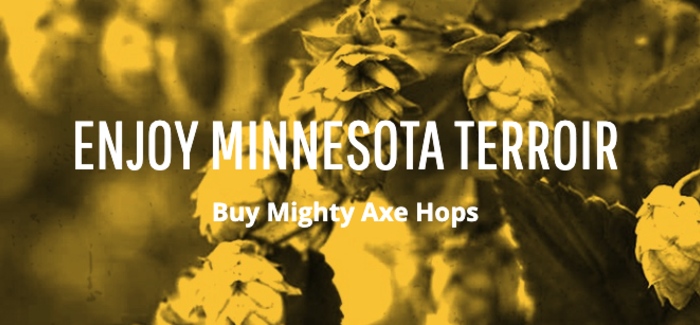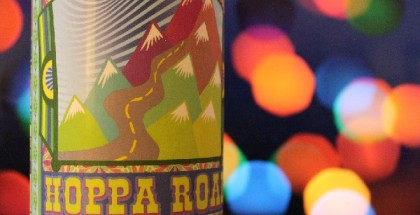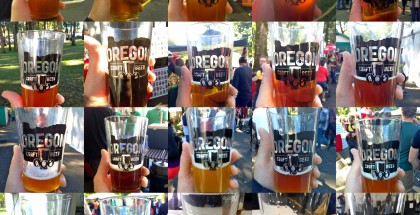The State of Independent Hop Farming
Mighty Axe Hops is an 80-acre hop farm located near Foley, Minnesota, roughly a 90-minute drive northwest from Minneapolis. It’s the largest hop farm from Michigan to Idaho and grows 13 varieties of hops.
In some capacity, most breweries around the Twin Cities partner with Mighty Axe Hops for Julius, Cascade, Comet, Centennial, Chinook and additional varieties. Mighty Axe also works with breweries around the country and ships internationally to Brazil, Canada and Sweden.
As one of the country’s small, independent hop farms, Mighty Axe Hops CEO Eric Sannerud takes a long view approach to hop production. A method that asks, how do we tend our yard so it will continue to produce for decades into the future?
“It’s both a sustainability approach and an economic approach,” says Sannerud. “There’s a long story about what the hop industry has become in the last five years. Private varieties control it, and the benefits are accrued to a tiny number of people.”
Out-There Labels, Fun Names and Proprietary Hops
There’s nothing more representative to the current landscape of craft beer than what’s found on liquor store shelves. While perusing, you’ll undoubtedly come across complex beers with many ingredients, vibrant, boisterous labels and fun names.
This landscape makes enjoyable beers. They’re wildly tasting with intense aromas, but there is a downside to it. It’s what can’t be seen that is harmful to small farmers.
“It’s difficult for an independent farmer to make it in hops right now,” explains Sannerud. “The majority of hop acreage in America is proprietary, and these private hop varieties are owned by companies who dominate the industry.”
Privately Held, Publically Dominate
Arguably the most well-known of these private varieties is Citra, which in 2018 became the first proprietary hop to reach the highest acreage of all U.S.-grown varieties, according to the Hop Growers of America (HGA) 2018 Statistical Report.
Citra hops currently retail for around $20-30 per pound, a price Sannerud says is unheard of in the industry. That’s because currently Citra hops are considered by many as the darling of the hop world, known for tones of grapefruit, melon, lime, gooseberry and passion fruit. Although darling, Sannerud claims that it’s largely because of these varieties that our IPAs are so expensive these days.
Unfortunately for growers like Sannerud, a majority of hops currently in demand by brewers and consumers are bred privately, requiring a hefty licensing fee. In turn, this drives up the cost for the farmer to grow the plant material and harvest the crop. The economic model eventually increases costs for the brewer and the consumer (you).
Comparatively, Mighty Axe hops are an average of $10 per pound.
Impacts on Quality
The idea of hop quality also plays a role in the current industry model.
“Cascade, Centennial, Crystal and Columbus are classic hop varieties that we’re all familiar with, but those aren’t cool anymore,” says Sannerud. “And since they don’t make as much money as Citra, they’re not being grown to the same level of quality as they used to.”
The example Sannerud provides lays out the incentive. If you’re a farmer out west and you have a contract to grow 1,000 acres of Citra and you also grow 1,000 acres of Cascade. However, you’re beholden to your contract for the Citra acres. They might tell you how to grow them, when to harvest them, how to dry them, etc.
“If you’re required to harvest the Citra acres at the same time you’re supposed to be harvesting the Cascade acres, you’re harvesting the Citra,” explains Sannerud. “If you don’t, you could be prevented from growing Citra again, which might be terrible for your farm.”
Quality and Market Control
The licensing design for proprietary hops is mainly twofold. There’s a significant quality control aspect to it. As terroir becomes more prevalent in the craft beer industry, proprietary hops want consistency in their crop, free from geographic variables.
But there is also a market control aspect. And, as Sannerud puts it, it’s why you see $24 four-packs at your local liquor store.
In response, some breweries are adjusting their consumer persona. Specifically, Sannerud mentions in conversations with a brewer, their primary market is currently males who are age 45 and older. A market with expendable income.
Undoubtedly, regional growers can make amazing things happen out of Cascade, Centennial, Chinook and Comet varieties. But most of the beers consumers are drinking either don’t contain those varieties or include varieties that are at least $15 per pound.
“If you’re picking up a can of beer that lists the hops in the beer, and it says Galaxy, Citra Cryo and Sabro, the ingredient cost on that beer is insane,” says Sannerud. “It explains why it might be so expensive. It starts with the ingredient cost.”
A Light Through the Haze
As hazy IPAs become slightly oversaturated in the market and lighter styles are circling back around the sun, independent hop farmers are keeping an eye on the trend. However, Sannerud sees the shift as more of a “side trend” and one that won’t come full circle.
“I’m waiting around for when people think west coast IPAs are fun again,” says Sannerud. “An IPA that’s clear and mostly based malt but has a more complex flavor and stronger finish than hazy technically does.”
In their second planting of hops, Mighty Axe planted Triple Pearl, Sterling, Crystal and Tahoma hops. All of these hops are used more in the lighter styles. It’s a move so Mighty Axe can have the gamut of what a brewer wants, whether it’s a pilsner or hazy.
A Small Farm’s Best Friend
When discussing customers, Sannerud lays out the model of a successful independent grower/brewer relationship.
“The breweries that are considered small—1,000-3,000 barrels per year but have an experienced brewer—are the best customers,” explains Sannerud. “A brewer who is tapped into the day-to-day work and is familiar with aspects of ingredient sourcing.”
In the winter, Sannerud visits all his customers, and in the summer, many visit the farm to hang out. Regular contact is critical, and Sannerud wants his customers to feel comfortable texting him any time about anything. To him, it’s the ideal relationship to problem solve. From a business perspective, Sannerud and Mighty Axe are looking to build 50 customers that fit this profile.
Turning to Terroir
Faced with an unfavorable market, Mighty Axe is becoming one of a few hop farms in the country, leaning into the idea of terroir and hops.
Terroir is the simple idea of where something is grown affects how it tastes. It’s prevalent in the wine and cheese industries. The concept for terroir is just as present in hops as it is in wine grapes, but it’s rarely talked about because, for the longest time, most hops came from the same general area.
Now, that tide is turning. The HGA 2018 Statistical Analysis included data from 26 states outside the Pacific Northwest, and most states in the country contain some level of hop production.
Another reason terroir is new territory for craft beer is that it hasn’t mattered. Until a few years ago, it didn’t matter what the hops were doing in a beer. It wasn’t about aroma.
“Craft beer wasn’t a nuanced experience. It was about a bitter experience,” says Sannerud. “We’re at the point in the industry now where we’re ready to have a conversation about how ingredient sourcing affects flavors and experience.”
The concept of terroir also applies to a sustainability perspective. Customers are becoming more interested in sustainability and the sourcing of their ingredients.
Following the Food Model
To help small independent farms, Sannerud wishes the craft beer space will start following the example set by the food industry.
“We can learn a lot from the food industry,” says Sannerud. “It’s hard to go to a restaurant or grocery store these days and not have them indicate where their beef is from.”
Admittedly, Sannerud struggles to understand the disconnect of why brewers aren’t talking about where their ingredients are from—whether they’re proprietary or not.
“If your customers learn that an IPA has Minnesota hops and you’re selling it in Minnesota, that can help it move faster because consumers are looking for that local connection,” says Sannerud. “The average beer consumer is someone who wants to eat locally. They go to farmer’s markets and cooperatives. They care about local sourcing.”
But the onus is also on us as the consumer. Many of us forget how important it is to talk to our bartenders about the hops in their beers. By knowing varieties, we become more informed beer drinkers. Doing so can also help you and your palate in the long run. Over time, maybe you realize you don’t really care for Centennial or Citra beers and just couldn’t put your finger on it before.
“Like in food, change is driven by consumers asking questions and making their preferences known, talking to suppliers and saying, ‘Hey, this matters to me,'” says Sannerud. “Eventually, ingredient sources will adjust purchasing practices.”
Starting at the Source for Small Farms
Sannerud has these conversations with brewers, and he understands how difficult it can be for the brewing industry to talk about their ingredients because it’s not something they’ve done before.
The craft industry is learning to talk about what sort of hops they use, and brewers are incorporating hop names into their packaging and marketing story. Still, it’s talking about the name and the source at the same time is difficult for people.
As the industry continues to move forward and trends come and go, I believe one thing will continue becoming more prevalent. When it comes to what’s in their beer, people will want to start at the source. Fortunately, I believe that can only mean good things for our small, independent hop farmers.
Feature image courtesy of Mighty Axe Hops








Submit a Comment